PepperPedia

7-Pot
Extremely hot pepper from Trinidad, with over 1 million Scoville Heat Units (SHU). It has a fruity and nutty flavor, and its name comes from the claim that one pepper can spice seven pots of stew.

Aji Amarillo
A bright orange, medium-hot pepper commonly used in Peruvian cuisine for its fruity flavor.

Aji Fantasy
Aji Fantasy Peppers are part of the Capsicum baccatum species, known for their unique lantern-like shape and sweet, citrusy flavor. They have a low to medium heat level, typically ranging from 5,000 to 10,000 Scoville Heat Units (SHU), making them suitable for a variety of dishes, including salads and salsas.

Aji Panca
Ají panca, Peruvian red pepper, is a variety of Capsicum baccatum (a chili pepper) grown in Peru and used in Peruvian cuisine. It is commonly grown on the coast of Peru and measures 3 to 5 in (7.6 to 12.7 cm) long and 1 to 1.5 in (2.5 to 3.8 cm) across. It has thick flesh and fruity overtones, it turns deep red to burgundy when ripe. It is commonly sun-dried at the farms and sold dry. It is very mild and if deseeded and deveined is considered to have no heat but is instead used for its flavor and color.

Aji Pineapple
Aji Pineapple Peppers are a vibrant, Peruvian variety of the Capsicum baccatum species. They are known for their bright yellow color, pendant-like shape, and a flavor profile that is tart, citrusy, and floral, with hints of tropical fruitiness. The peppers typically range from 2 to 3 inches in length and are highly productive.

Aleppo
The Aleppo pepper has a moderate heat level of about 10,000 on the Scoville scale, with some fruitiness and mild, cumin-like undertones. Its flavor is similar to the ancho chile, but oilier and slightly salty; salt is often used in the drying process. It is fairly mild, with its heat building slowly, with a fruity, raisin-like flavor.

Ancho / Poblano
A dried poblano pepper with a mild heat and sweet, raisin-like flavor, commonly used in Mexican mole sauces. The poblano (Capsicum annuum) is a mild chili pepper originating in Puebla, Mexico. Dried, it is called ancho or chile ancho, from the Spanish word ancho (wide).

Bahamian
Bahamian Peppers are small, round peppers that grow about an inch in length and come in various colors such as yellow, orange, green, and red. They are known for their intense heat, ranging from 95,000 to 110,000 Scoville Heat Units (SHU), making them hotter than cayenne peppers but not as hot as most habaneros.

Banana
The banana pepper (also known as the yellow wax pepper or banana chili) is an average-sized member of the chili pepper family that has a mild, tangy taste. While typically bright yellow, it is possible for them to change to green, red, or orange as they ripen. It is often pickled, stuffed or used as a raw ingredient in foods. It is a cultivar of the species Capsicum annuum. Its flavor is not very hot (0–500 Scoville units) and, as is the case with most peppers, its heat depends on the maturity of the pepper, with the ripest being sweeter than younger ones.
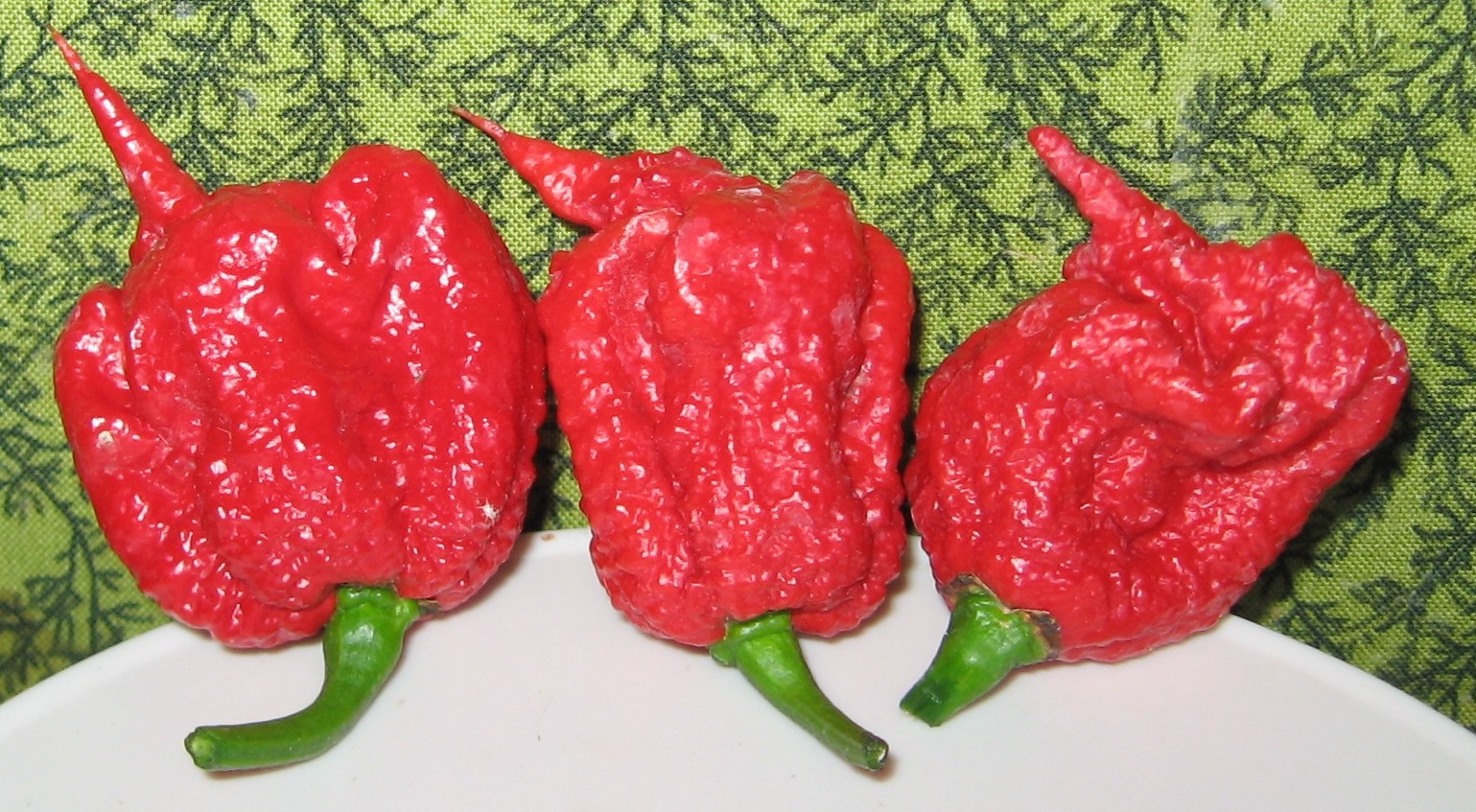
Carolina Reaper
The Carolina Reaper chili pepper is a cultivar of the Capsicum chinense plant. Developed by American breeder Ed Currie, the pepper is red and gnarled, with a bumpy texture and small pointed tail. It was the hottest chili pepper in the world according to Guinness World Records from 2013 to 2023 before it was surpassed by Pepper X, which was also developed by Currie.

Chile de Arbol
The Chile de árbol (lit. 'chili from tree') is a small and potent Mexican chili pepper also known as bird's beak chile and rat's tail chile. These chilis are about 5 to 7.5 cm (2.0 to 3.0 in) long, and 0.65 to 1 cm (0.26 to 0.39 in) in diameter. Their heat index is between 15,000 and 30,000 Scoville units. The peppers start out green and turn a bright red color as they mature. Chile de árbol peppers can be found fresh, dried, or powdered. As dried chiles, they are often used to decorate wreaths because they do not lose their red color after dehydration.

Chocolate Habanero
Black habanero is an alternative name often used to describe the dark brown variety of chocolate habanero chilis (although they are slightly different, being slightly smaller and slightly more sphere-shaped). Some seeds have been found which are thought to be over 7,000 years old. The black habanero has an exotic and unusual taste, and is hotter than a regular habanero with a rating between 425,000 and 577,000 Scoville units. Small slivers used in cooking can have a dramatic effect on the overall dish. The chocolate habaneros take considerably longer to grow than other habanero chili varieties.

Datil
Datil is a variety of the species Capsicum chinense (syn. Capsicum sinense) grown in St. Augustine, Florida. Datil has a heat level similar to habanero with a sweet spicy taste. The datil pepper has a similar Scoville as well, ranging between 100,000 and 300,000. The time till maturity for the pepper is approximately 5 months and the plant can grow 18 inches (1 ft 6 in). Its color ranges between green, yellow and orange. A mature datil pepper is 3-4 cm long with a blunt tip, a golden-orange color and weighs 3 grams.

Douglah (7-Pot)
Also known as the 7-Pot Douglah, this is one of the hottest peppers in the world, with a dark brown color and nutty flavor. A chocolate brown 7-Pot variant, extremely hot with a fruity undertone. Typically measures between 923,889 – 1,853,986 SHU.

Fatalii
The Fatalii is a cultivar of the chili pepper Capsicum chinense developed in southern or central Africa from chilies introduced from the Americas. It is described as having a fruity, citrus flavor with a searing heat comparable to the habanero, to which it is related and from which it may have derived.

Ghost
The ghost pepper, also known as bhut jolokia (lit. 'Bhutanese pepper' or 'Ghost pepper' in Assamese), is an interspecific hybrid chili pepper cultivated in Northeast India. It is a hybrid of Capsicum chinense and Capsicum frutescens. In 2007, Guinness World Records certified that the ghost pepper was the world's hottest chili pepper, 170 times hotter than Tabasco sauce. The ghost chili is rated at more than one million Scoville Heat Units (SHUs) and far surpasses the amount of a cayenne pepper.

Gochugaru
A Korean chili pepper used in flakes or powder form, known for its mild heat and slightly sweet flavor. The chili pepper is long, slender and mild in flavor and spice. Chili peppers, which originated in the Americas, were introduced by Portuguese traders to Korea, via Japan, in the late 16th century.

Habanero
The habanero is a pungent cultivar of Capsicum chinense chili pepper. Unripe habaneros are green, and they color as they mature. The most common color variants are orange and red, but the fruit may also be white, brown, yellow, green, or purple. Typically, a ripe habanero is 2–6 centimetres (3⁄4–2+1⁄4 inches) long. Habanero chilis are very hot, rated 100,000–350,000 on the Scoville scale.

Jalapeño
The jalapeño is a medium-sized chili pepper pod type cultivar of the species Capsicum annuum. A mature jalapeño chili is 5–10 cm (2–4 in) long and 25–38 mm (1–1+1⁄2 in) wide, and hangs down from the plant. The pungency of jalapeño peppers varies, but is usually between 4,000 and 8,500 units on the Scoville scale. Commonly picked and consumed while still green, it is occasionally allowed to fully ripen and turn red, orange, or yellow. It is wider and generally milder than the similar Serrano pepper.

Manzano
Capsicum pubescens is a plant of the genus Capsicum (pepper). The species name, pubescens, refers to the hairy leaves of this pepper. The hairiness of the leaves, along with the black seeds, make Capsicum pubescens distinguishable from other Capsicum species. Capsicum pubescens has pungent yellow, orange, red, green or brown fruits. This species is found primarily in Central and South America, and is known only in cultivation. It is consumed fresh, as a paste, dried, or ground. It is called rocoto (Quechua, rukutu, ruqutu) in Peru and Ecuador, locoto in Bolivia and Argentina (Aymara, luqutu), and in Mexico manzano (Spanish for "appletree") pepper for its apple-shaped fruit. Of all the domesticated species in the genus Capsicum, it is the least widespread and most genetically distinct.
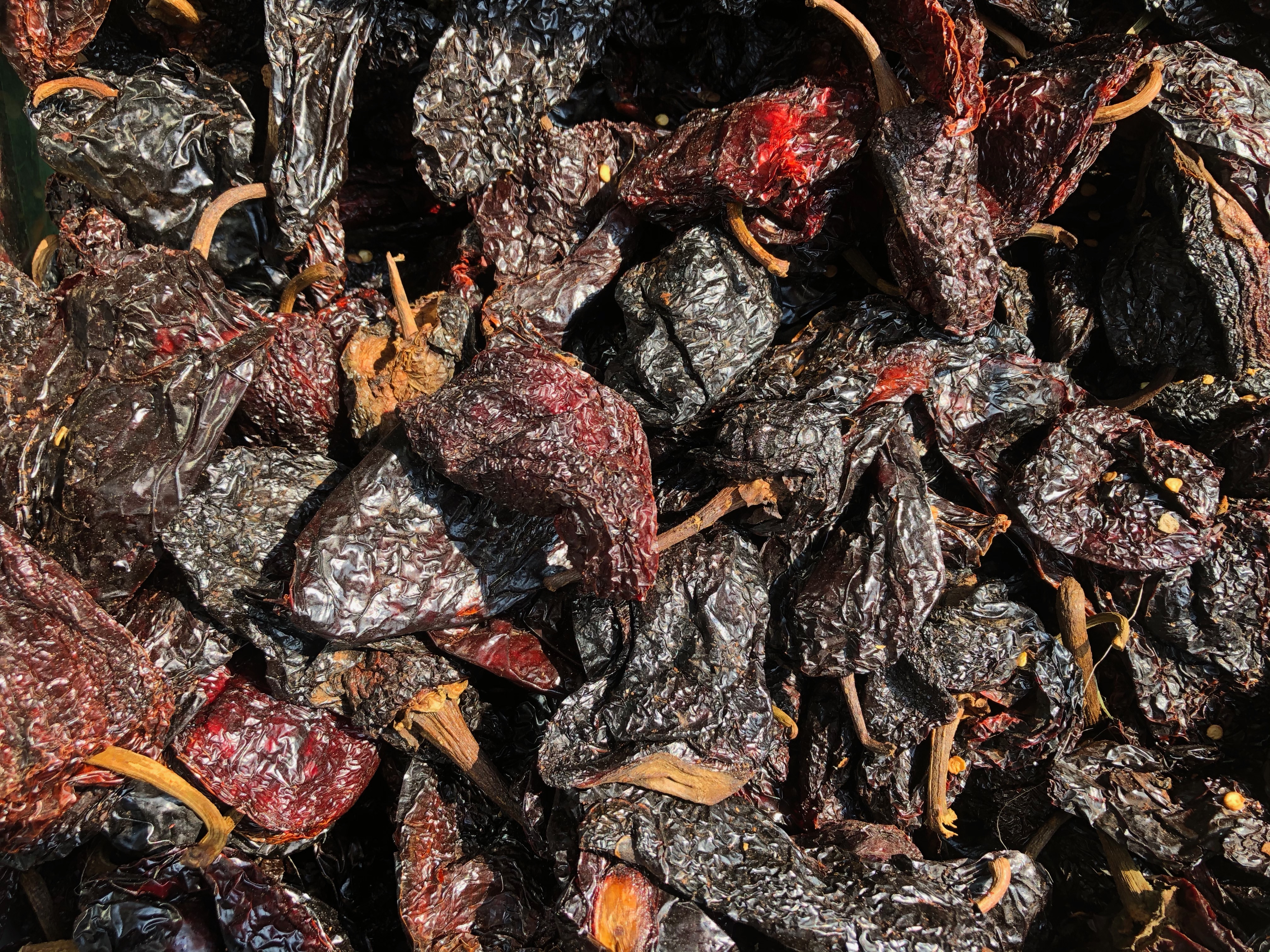
Morita
A type of chipotle pepper made from smoked, dried red jalapeños, with a sweet and smoky flavor.
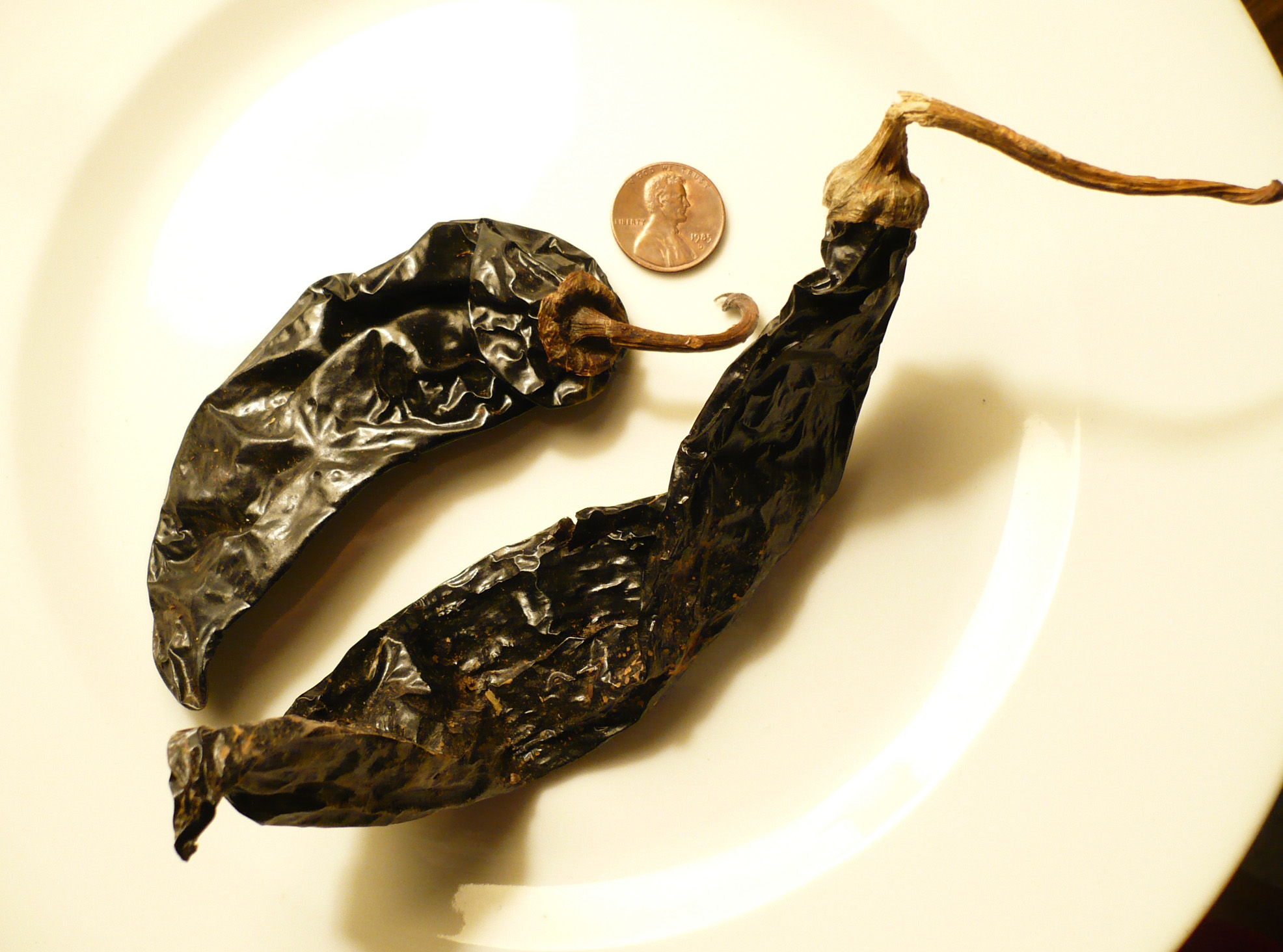
Pasilla
The pasilla chile or chile negro is the dried form of the chilaca chili pepper, a long and narrow member of the species Capsicum annuum. Named for its dark, wrinkled skin (literally "little raisin"),[2] it is a mild to hot, rich-flavored chile. As dried, it is generally 6 to 8 inches (15 to 20 cm) long and 1 to 1+1⁄2 inches (2.5 to 3.8 cm) in diameter. The fresh narrow chilaca can measure up to 9 inches (230 mm) long and often has a twisted shape, which is seldom apparent after drying. It turns from dark green to dark brown when fully mature.

Pepper X
The hottest pepper in the world as of 2023, with a Scoville rating of 2.69 million, developed by the creator of the Carolina Reaper. Pepper X is a cultivar of Capsicum chili pepper bred by the American chili breeder Ed Currie, the creator of the Carolina Reaper. Pepper X resulted from several cross breedings that produced an exceptionally high content of capsaicin in the locules – the plant tissue holding the seeds. The extensive curves and ridges of a Pepper X chili create more surface area for the plant placenta and locules to grow and retain capsaicin, adding to the intensity of heat experienced when a Pepper X is eaten. Ingestion of a Pepper X chili causes intense abdominal cramps and heartburn.
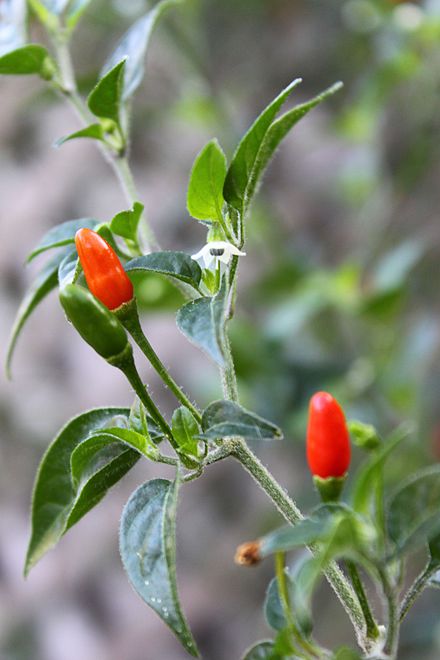
Pequin (piquín)
Pequin is a hot chili pepper cultivar, often 5–8 times hotter than jalapeños on the Scoville scale (30,000 to 60,000 Units). Flavor is described as citrusy and nutty.It is classified within variety glabriusculum of the species Capsicum annuum. Pequin pepper originates in the Mexican state of Tabasco. Pequin has a compact habit, growing typically 0.3–0.6 meters tall, with bright green, ovate leaves and small berries that rarely exceed 2 cm in length. Like most chilies, the berries start out green, ripening to brilliant red at maturity.

Peter Pepper
Peter Peppers are known for their unique, phallic shape and are part of the Capsicum annuum species. They have a bright, sweet flavor mixed with a moderate to hot level of spice. The peppers range from 5,000 to 30,000 Scoville Heat Units (SHU), though they commonly average between 10,000 to 23,000 SHU.

Piri piri (peri-peri)
Peri-peri, also known as African bird's eye chili, is a cultivar of Capsicum frutescens from the malagueta pepper. It was originally produced by Portuguese explorers in Portugal's former Southern African territories and then spread to other Portuguese domains.

Rocoto
A thick-walled, juicy Andean pepper with a fruity taste and strong heat; 30,000-100,000 SHU.

Scotch Bonnet
Scotch bonnet (also known as Bonney peppers, or Caribbean red peppers) is a variety of chili pepper named for its supposed resemblance to a Scottish tam o' shanter bonnet. It is native to the Americas—a cultivar of Capsicum chinense, which originated in the Amazon Basin, Central and South America. A Caribbean favorite, wrinkled and hot with a sweet-fruity flavor; 100,000-350,000 SHU.

Serrano
The serrano pepper (Capsicum annuum) is a type of chili pepper that originated in the mountainous regions of the Mexican states of Puebla and Hidalgo. The Scoville rating of the serrano pepper is 10,000 to 25,000. The name of the pepper is a reference to the mountains (sierras) of these regions. The pepper is commonly used to make hot sauces.

Shishito
The pepper is small and finger-long, slender, and thin-walled. Although it turns from green to red upon ripening, it is usually harvested while green. The name refers to the fact that the tip of the chili pepper (唐辛子, tōgarashi) looks like the lion (獅子, shishi) head; in Japanese, it is often abbreviated as shishitō.

Sugar Rush
Sugar Rush Chili Peppers, specifically the Sugar Rush Peach variety, are elongated peppers with a cylindrical shape, ripening from green to a vibrant peach color. They are known for their sweet, fruity flavor with notes of apricot, peach, and citrus, followed by a moderate to hot level of spice. The peppers are part of the Capsicum baccatum species and are highly productive, making them ideal for hot sauces and various culinary applications.

Trinidad Moruga Scorpion
The Trinidad Moruga scorpion (a cultivar of Capsicum chinense) is a chili pepper native to the village of Moruga, Trinidad and Tobago. In 2012, New Mexico State University's Chile Pepper Institute identified the Trinidad Moruga scorpion as the hottest chili pepper at that time, with heat of 1.2 million Scoville heat units (SHUs). Paul Bosland, a chili pepper expert and director of the Chile Pepper Institute, said, "You take a bite. It doesn't seem so bad, and then it builds and it builds and it builds. So it is quite nasty." Aside from the heat, the Trinidad Moruga scorpion has a tender fruit-like flavor, which makes it a sweet-hot combination.
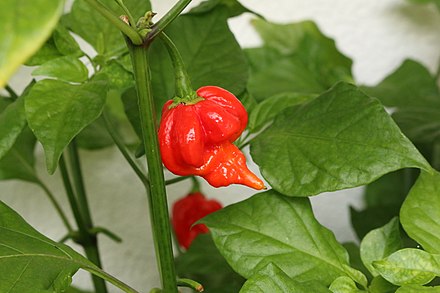
Trinidad Scorpion Butch T
The Trinidad Scorpion Butch T is a Capsicum chinense cultivar that is among the hottest peppers in the world. It is a hybrid pepper and thus not indigenous to anywhere; however, its hybrid parentage is derived from the Trinidad Moruga scorpion indigenous to Trinidad and Tobago. It was named by Neil Smith from The Hippy Seed Company, after he got the seeds originally from Butch Taylor (the owner of Zydeco Farms in Woodville/Crosby, Mississippi, and a hot sauce company) who is responsible for propagating the pepper's seeds. The "scorpion" peppers are referred to as such because the pointed end of the pepper is said to resemble a scorpion's stinger.